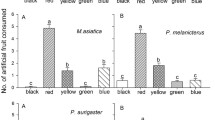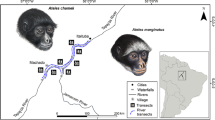Abstract
Use patterns of lipid-rich, fleshy fruits were examined for frugivorous birds. Approximately 20% of fleshy-fruited species within plant communities bear fruit with >10% dry weight lipids. These fruits are fed upon by the most heavily frugivorous bird species in those communities studied and are the focus of highly specialized relationships among birds and fruits. In aviary tests some temperate frugivores show preference for higher lipid native fruits and prefer higher-lipid artificial fruits with as little as 3% wet weight difference in lipid content. The importance of lipids in fruit preference by birds, and the possible effects of differing digestive physiologies in birds are discussed.
Similar content being viewed by others
References
Baird, J. W. 1980. The selection and use of fruit by birds in an eastern forest. Wilson Bulletin 92: 63–73.
Borowicz, V. A. & Stephenson, A. G. 1985. Fruit composition and patterns of fruit dispersal of two Cornus spp. Oecologia 67: 435–441.
Davidar, P. 1983. Birds and neotropical mistletoes: effects on seedling recruitment. Oecologia 60: 271–273.
Debussche, M. & Isenmann, P. 1989. Fleshy fruit characters and the choices of bird and mammal seed dispersers in a Mediterranean region. Oikos 56: 327–338.
Denslow, J. S. & Moermond, T. C. 1982. The effect of accessibility on rates of fruit removal from tropical shrubs: an experimental study. Oecologia 54: 170–176.
Denslow, J. S., Moermond, T. C. & Levey, D. J. 1986. Spatial component of fruit display in understory trees and shrubs. Pages 37–44 in A. Estrada and T. H. Fleming, eds. Frugivores and seed dispersal. Junk, Dordrecht.
Diamond, A. W. & Place, A. R. 1988. Wax digestion in blackthroated honeyguides, Indicator indicator. Ibis 130: 558–561.
Dinerstein, E. 1986. Reproductive ecology of fruit bats and the seasonality of fruit production in a Costa Rican cloud forest. Biotropica 18: 307–318.
Docters van Leeuwen, W. M. 1954. On the biology of some Loranthaceae and the role birds play in their life-history. Beaufortia 4: 105–208.
Goodwin, T. W. & Mercer, E. I. 1983. Introduction to plant biochemistry, 3rd edition. Pergamon Press, Oxford.
Greenberg, J. W. 1981. Frugivory in some migrant tropical forest wood warblers. Biotropica 13: 215–223.
Herbst, L. H. 1986. The role of nitrogen from fruit pulp in the nutrition of the frugivorous bat Carollia perspicillata. Biotropica 18: 39–44.
Herrera, C. M. 1981a. Datos sobre la dieta frugivora del Mirlo (Turdus merula) en dos localidades del sur de espana. Donana Acta Vertebrata 8: 306–310.
Herrera, C. M. 1981b. Fruit food of robins wintering in southern Spanish mediterranean scrubland. Bird Study 28: 115–122.
Herrera, C. M. 1982. Seasonal variation in the quality of fruits and diffuse coevolution between plants and avian dispersers. Ecology 63: 773–785.
Herrera, C. M. 1984. A study of avian frugivores, birddispersed plants, and their interaction in Mediterranean scrublands. Ecological Monographs 54: 1–23.
Howe, H. F. & DeSteven, D. 1979. Fruit production, migrant bird visitation, and seed dispersal in Guarea glabra in Panama. Oecologia 39: 185–196.
Howe, H. F. & Estabrook, G. F. 1977. On intraspecific competition for avian dispersers in tropical trees. American Naturalist 111: 817–832.
Howe, H. F. & Smallwood, J. 1982. Ecology of seed dispersal. Annual Review of Ecology and Systematics 13: 201–228.
Howe, H. F. & Vande Kerckhove, G. A. 1980. Nutmeg disperal by tropical birds. Science 210: 925–927.
Jackson, S. & Place, A. R. 1990. Gastrointestinal transit and lipid assimilation efficiencies in three species of high latitude seabird. J. Exper. Zool. 255: 141–154.
Johnson, D. H. 1980. The comparison of usage and availability measurements for evaluating resource preference. Ecology 61: 65–71.
Johnson, R. A., Willson, M. F., Thompson, J. N. & Bertin, R. I. 1985. Nutritional values of wild fruits and consumption by migrant frugivorous birds. Ecology 66: 819–827.
Jordano, P. 1984. Seed weight variation and differential avian dispersal in blackberries (Rubus ulmifolius). Oikos 43: 149–153.
Jordano, P. 1988. Diet, fruit choice and variation in body condition of frugivorous warblers in Mediterranean scrublands. Ardea 76: 193–209.
Knight, R. S. & Siegfried, W. R. 1983. Inter-relationships between type, size and colour of fruits and dispersal in southern African trees. Oecologia 56: 405–412.
Lederer, R. J. 1977a. Winter territoriality and foraging behavior of the Townsend's solitaire. American Midland Naturalist 97: 101–109.
Lederer, R. J. 1977b. Winter feeding territories in the Townsend's solitaire. Bird-banding 48: 11–18.
Lederer, R. J. 1980. Facultative territoriality in the Townsend's solitaire (Myadestes townsendi). Southwest Naturalist 25: 129–136.
Levey, D. J., Moermond, T. C. & Denslow, J. S. 1984. Fruit choice in neotropical birds: the effect of distance between fruits on preference patterns. Ecology 65: 844–850.
Manasse, R. S. & Howe, H. F. 1983. Competition for dispersal agents among tropical trees: influence of neighbors. Oecologia 59: 185–190.
Martin, A. C., Zim, H. S. & Nelson, A. L. 1951. American wildlife and plants. McGraw-Hill, New York.
Martinez del Rio, C. & Stevens, B. R. 1989. Physiological constraint on feeding behavior: intestinal membrane disaccharides of the starling. Science 243: 794–796.
Martinez del Rio, C., Stevens, B. R., Daneke, D. E. & Andreadis, P. T. 1988. Physiological correlates of preference and aversion for sugars in three species of birds. Physiol. Zool. 61: 222–229.
McKey, D. 1975. The ecology of coevolved seed dispersal systems. Pages 159–191 in L. E. Gilbert and P. H. Raven eds. Coevolution of animals and plants. University of Texas Press, Austin.
McPherson, J. M. 1987. A field study of winter fruit preferences of cedar waxwings. Condor 89: 293–306.
Moore, L. A. & Willson, M. F. 1982. The effect of microhabitat, spatial distribution, and display size on dispersal of Lindera benzoin by avian frugivores. Canadian Journal of Botany 60: 557–560.
Moermond, T. C. & Denslow, J. S. 1983. Fruit choice in neotropical birds: effects of fruit type and accessibility on selectivity. Journal of Animal Ecology 52: 407–420.
Moermond, T. C. & Denslow, J. S. 1985. Neotropical avian frugivores: patterns of behavior, morphology, and nutrition with consequences for fruit selection. Pages 865–897 in P. A. Buckley, M. S. Foster, E. S. Morton, R. S. Ridgely, and F. Buckley, eds. Neotropical ornithology. Ornithological Monograph 36.
Obst, B. S. 1986. Wax digestion in Wilson's storm-petrel. Wilson Bull. 98: 189–195.
Paine, R. T. 1971. The measurement and applications of the calorie to ecological problems. Annual Review of Ecology and Systematics 2: 145–164.
Piper, J. K. 1986. Seasonality of fruit characters and seed removal by birds. Oikos 46: 303–310.
Place, A. R. & Stiles, E. W. 1992. Living off the wax of the land: bayberries and yellow-rumped warblers. Auk 109: 334–345.
Place, A. R., Stoyan, N., Butler, R. G. & Ricklefs, R. R. 1989. The physiological basis of stomach oil formation in Leach's storm-petrel, Oceanodroma leucorhoa. Auk 106: 687–699.
Poddar, S. & Lederer, R. J. 1982. Juniper berries as an exclusive winter forage for Townsend's solitaires. American Midland Naturalist 108: 34–40.
Pratt, T. K. & Stiles, E. W. 1985. The influence of fruit size and structure on composition of frugivore assemblages in New Guinea. Biotropica 17: 314–321.
Roby, D., Place, A. R. & Ricklefs, R. R. 1986. Assimilation and deposition of wax esters in planktivorous seabirds. J. Exp. Zool. 239: 29–41.
Salomonson, M. J. 1978. Adaptation for animal dispersal of one seed juniper seeds. Oecologia 32: 333–339.
Salomonson, M. J. & Balda, R. P. 1977. Winter territoriality of Townsend's solitaires (Myadestes townsendi) in a pinon juniper-ponderosa pine ecotone. Condor 79: 148–161.
Skeate, S. T. 1985. Mutualistic interactions between birds and fruits in a northern Florida hammock community. PhD Thesis. University of Florida, Gainesville, Florida.
Snow, B. K. 1970. A field study of the bearded bellbird in Trinidad. Ibis 112: 299–329.
Snow, B & Snow, D. 1988. Birds and berries. Poyser, Calton.
Snow, D. W. 1962. The natural history of the oilbird, Steatornis caripensis, in Trinidad, W.I. Part II. Population, breeding ecology and food. Zoologica 47: 199–221.
Snow, D. W. 1971. Evolutionary aspects of fruit-eating by birds.
Snow, D. W. 1981. Tropical frugivorous birds and their food plants: a world survey. Biotropica 13: 1–14.
Snow, D. W. 1982. The cotingas. British Museum (Natural History).
Sorensen, A. E. 1983. Taste aversion and frugivore preference. Oecologia 56: 117–120.
Stiles, E. W. 1980. Patterns of fruit presentation and seed dispersal in bird-disseminated woody plants in the eastern deciduous forest. American Naturalist 116: 670–688.
Stiles, E. W. 1982. Fruit flags: two hypotheses. American Naturalist 120: 500–509.
Stiles, E. W. 1989. Fruits, seeds, and dispersal agents. Pages 87–122 in W. G. Abrahamson ed. Plant-animal interactions, McGraw-Hill, New York.
Stiles, E. W. & White, D. W. 1982. Additional information on birddisseminated fruits: response to Herrera's comments. American Naturalist 120: 823–827.
Thompson, J. N. & Willson, M. F. 1979. Evolution of temperate fruit/bird interactions: phenological strategies. Evolution 33: 973–982.
Turcek, F. J. 1963. Color preference in fruit and seed-eating birds. Proceedings of the International Ornithological Congress 13: 285–292.
Walsberg, G. E. 1975. Digestive adaptations of Phainopepla nitens associated with the eating of mistletoe berries. Condor 77: 169–174.
Wetmore, A. 1914. The development of the stomach in the euphonias. Auk 31: 458–461.
Wheelwright, N. T. 1983. Fruits and the ecology of the resplendent quetzal. Auk 100: 286–301.
Wheelwright, N. T. 1985. Fruit size, gape width, and the diets of fruit-eating birds. Ecology 66: 808–818.
Wheelwright, N. T., Haber, W. A., Murray, K. G. & Guindon, C. 1984. Tropical fruit-eating birds and their food plants: a survey of a Costa Rican lower montane forest. Biotropica 16: 173–192.
Wheelwright, N. T. & Janson, C. H. 1985. Colors of fruit displays of bird-dispersed plants in two tropical forests. American Naturalist 126: 777–799.
White D. W. 1989. North American Bird-dispersed fruits: ecological and adaptive significance of nutritional and structural traits. PhD Thesis. Rutgers University, New Brunswick, New Jersey.
White, S. C. 1974. Ecological aspects of growth and nutrition in tropical fruit-eating birds. PhD thesis. University of Pennsylvania, Philadelphia, Pennsylvania.
Willson, M. F., Irvine, A. K. & Walsh, N. G. 1989. Vertebrate dispersal syndromes in some Australian and New Zealand plant communities, with geographic comparisons. Biotropica 21: 133–147.
Willson, M. F. & Thompson, J. N. 1982. Phenology and ecology of color in bird-dispersed fruits, or why some fruits are red when they are ‘green’. Canadian Journal of Botany 60: 701–713.
Willson, M. F. & Whelan, C. J. 1990. The evolution of fruit color in fleshy-fruited plants. American Naturalist 136: 790–809.
Author information
Authors and Affiliations
Rights and permissions
About this article
Cite this article
Stiles, E.W. The influence of pulp lipids on fruit preference by birds. Vegetatio 107, 227–235 (1993). https://doi.org/10.1007/BF00052225
Issue Date:
DOI: https://doi.org/10.1007/BF00052225




